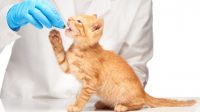Pepcid for cats has been known long for its goodness to treat cat’s vomiting. But is that all from this medication? How big is the side effect? What is the recommended dosage for your cat? All answers to these questions must be understood first before administering the medication to your lovely feline fellow, even though the drug is administered by your cat’s vet. It’s not that you don’t trust your vet, it’s just you need to understand better what medication that is administered to your cat.
What condition it is used?
Pepcid for cats is known for being the cure of cat’s vomiting. However, it is not all its benefits. According to sources, Pepcid is known to be used for several stomach-related problems, vomiting being one of the most reasons taken for administering this medication.
Often called as Famotidine (its technical name), this medication is also used to treat stomach ulcers in cats. It is also used to treat ulcers in intestine and several other intestinal problems.
In dealing vomiting, Famotidine works by cutting the amount of stomach acid production. This surely leads to lowered amount of stomach acid, hence reducing the cat’s trigger to vomit. Since the medication can be used to lower the stomach acid production, it can be used to avoid heartburn in cats as well, aside from GERD (gastroesophageal reflux disease).
Dosage of administration
Pepcid for cats dosage vary from one cat to another. However, in general, the safe dosage is between 0.25-0.5 mg for one pound. This is equal to 0.5-1.0 mg/kg for every 12-24 hours. For more perfect dosage counting, your vet will always be available for some help.
How it is administered
Pepcid, which is the popular brand for drugs containing Famotidine, is generally administered orally. But it can also be administered per injection in several emergency cases. Always follow your vet’s guidance about how to administer this medication so you can avoid any of these conditions:
- Skipping a dose,
- Administering more than is prescribed without any supervision, or
- Administering Pepcid more frequent without any preceding guidance.
- Possible Pepcid side effects post-administration
The main side effects of Pepcid administration are upset stomach, diarrhea, lowered energy, headache, and dizziness. Your cat may face one or more side effects, which is fine except if your cat is facing diarrhea or upset stomach. If your cat’s facing these two side effects, then another vet visit is highly recommended.
So, that’s the information about Pepcid, including what conditions will it target, how to administer it and its dosage, and its side effects. By understanding the details of Pepcid for cats, you will be able to understand how this medication works, as well as how the medication must be administered.






